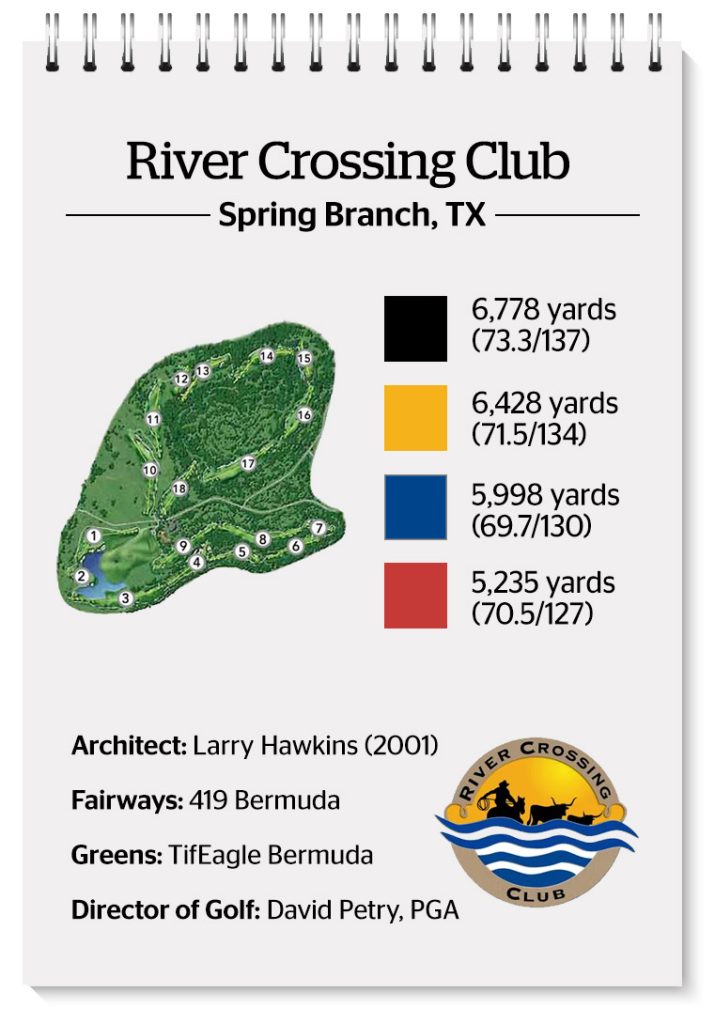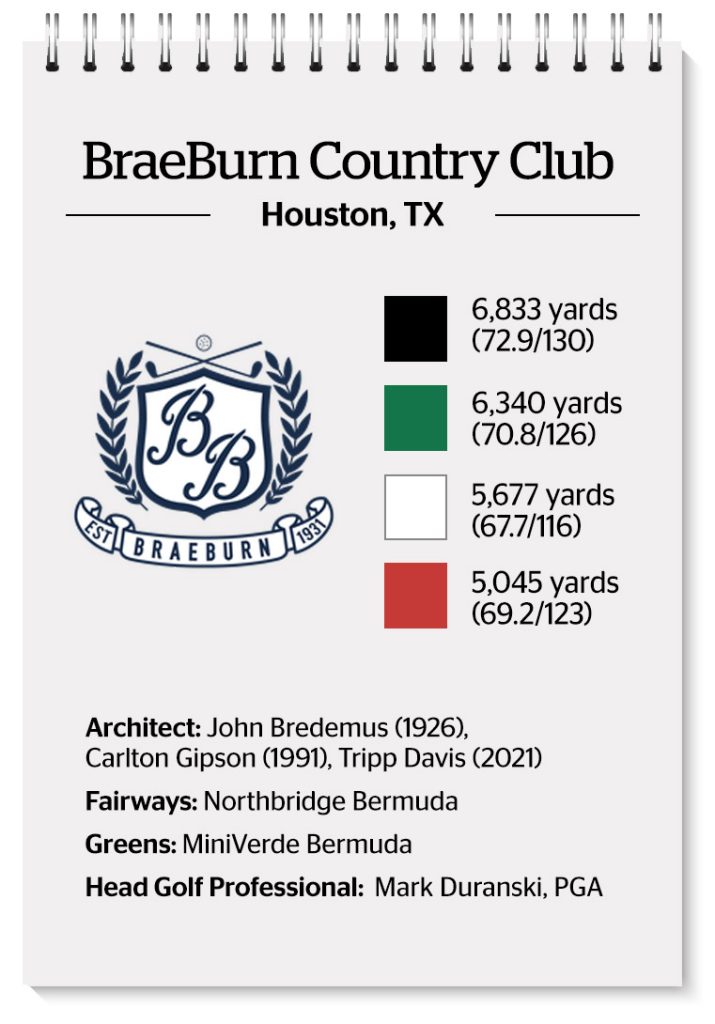Around the Green
The latest golf-related news, notes, and feature stories from the TGA.
Shyla Brown, Henry Guan make First-Ever U.S. National Junior Team
In a press release yesterday, the USGA announced the inaugural U.S. National Junior Team that includes Texans Shyla Brown and Henry Guan.
With the 2024 Olympics kicking off and the Presidents Cup taking place in September, the United States of America has a big year ahead in sports. The USGA elevated it more by grabbing golfers’ attention with their announcement for the U.S. Junior National Team. The team is the newest addition of the U.S. National Development Program which was established to make the United States the global leader in golf. The elite 10 girls and eight boys on the roster will represent the United States on a global level while nurturing the future of America’s top junior players.
The 18-player roster was announced on March 26th and will grow to 30 players over the next three years. The roster will be evaluated annually by a selection committee while the players will participate in bi-annual camps and compete internationally with the first international friendly taking place this summer against Australia. The players will also receive year-round world-class coaching, sports psychology, and nutritional guidance. By 2033, the USGA plans to have state pilot programs to launch players into the U.S. National Junior Roster.
Out of the eight boys and 10 girls announced for the U.S. National Junior Team, two familiar faces from Texas made the roster. Shyla Brown of McKinney and Henry Guan of Irving made the inaugural roster with other junior golfers from the states of Alabama, California, Florida, Kansas, North Carolina, Ohio, Tennessee, and Washington. Brown and Guan, both elite golfers, could not be more deserving of the recognition and the chance to represent the United States of America.
Shyla Brown, the 15-year-old sophomore and two-time Legends Junior Tour winner is coming off a strong 2023 and 2024 season. Brown was one of four junior golfers elected to compete in the Southwest Airlines Showcase, a collegiate event at Cedar Crest Golf Course in November. Brown showed off her skills finishing second behind Allyn Stephens of Houston. Earlier in the year, Brown finished second at the Texas Junior Amateur held at White Bluff Resort in Whitney, Texas. As if that wasn’t impressive already, she went on to finish eighth at the Texas Women’s Open, a professional event held by the Northern Texas PGA Section. Brown is just getting started and adding U.S. Junior National Team to her resume just shows the skill the Texas Golfer has.
Henry Guan of Irving has an impressive resume that helped propel him into the U.S. Junior National Team roster. The 425th-ranked World Amateur Golfer competed on the Junior Presidents Cup team alongside former Legends Junior Tour player Preston Stout. Guan finished secnd at the 2022 Veritex Bank Byron Nelson Junior Championship and heading into 2023 finished in the Top 20 at the U.S. Junior Amateur Championship. His list of achievements and wins in tournaments builds every year and playing on the U.S. Junior National Team will only make him more successful.
The eyes of Texas fall on Brown and Guan as they take this big step in junior golf but rest assured, they will be ready.
To read more on the U.S. Junior National Team selection, click here.
Around the Green
The latest golf-related news, notes, and feature stories from the TGA.
Mierl, Sanford tied for the lead at the Texas Cup Invitational
Tyler Sanford of Montgomery and Trenton Mierl of Austin share the lead after the First Round at the 2024 Texas Cup Invitational. Both players fired off a 3-under 68 to propel themselves to the top of the leaderboard at Eagle’s Bluff Country Club which is hosting the Texas Cup Invitational for the first time.
“I’m feeling good. My game felt sharp out there today,” shared Sanford. “I didn’t have any big mistakes out there, so it was a smooth round.” Sanford started his round with back-to-back birdies that helped set him up for a great round. After making a bogey on hole No. 7, he went on to score two more birdies on the back nine to stay at the top of the leaderboard. “I can take advantage of the par fives and get my driver out and go for it. I played the par threes well too which was an advantage for me.”
Mierl came into the Texas Cup right off his win at the 2024 Spring Preview Championship at Cedar Crest Golf Course. “It was a slow start out there,” shared the high school senior who started on No. 10 today. “I took it one shot at a time.” Mierl made five birdies on his back nine today including three straights to complete the round. “I got hot at the end especially after I chipped in on nine. I put myself in good positions and took advantage when I could.”
Tied for second are San Antonio’s Cameron Villarreal, Montgomery’s J.J. Worrell, and Round Rock’s Cole MacMillan after a two-under 69 for the First Round. “The course is nice, and the greens are rolling well. The par threes played long today but there were also some par fours that you can get after,” shared Worrell. “I got to stay feeling good and work on my tee shots tomorrow morning on the range. I need to keep the shots straighter and not have as many wayward shots.”
In a tight group tied for fifth are Charlie Dial of Fort Worth, Preston Hiller of San Antonio, Mitchell Maier of Richmond, Shiv Parmar of Selma, and Dylan Villarreal of McAllen after a First Round 1-under 70.
Colder weather welcomed the players in the morning with temperatures in the low 50’s. By the time all players made the turn, temperatures rose into the mid-to-high 60’s with a light breeze that made for a great day for golf.
Hole 13 played the toughest on the course today with an average score of 3.66. The 208-yard Par 3 sits in the pine trees where a crosswind from the south plays a major factor in landing on the green with a bunker on each side.
Official yardage for the First Round was 6,790 yards.
The Texas Cup Invitational, the first of the two boys-only majors on the LJT annual schedule, is the LJT boy’s first 54-hole event of the year.
The Second Round of the Texas Cup Invitational is scheduled for Tuesday, March 12 with tee times beginning at 8:30 AM. To see pairings, click here.
For more information on the Texas Cup Invitational, click here.
Around the Green
The latest golf-related news, notes, and feature stories from the TGA.
River Crossing Club
River Crossing Club in Spring Branch, located about 20 miles north of San Antonio, is a picturesque retreat from the everyday hustle and bustle where members and guests can enjoy an assortment of exceptional recreational and social activities with an emphasis on golf.
Nestled against the backdrop of the scenic Texas Hill Country, River Crossing opened in 2001 with an 18-hole championship course designed by Larry Hawkins.
Though part of a large master-planned community, the course has very little intrusion of development other than an occasional house peeking out through the trees. The clear and unobstructed playing sightlines create a sense of openness and flow that feels larger and more inviting.
Hawkins expertly used the innate features of the property to produce an engaging routing that traverses across gentle rolling terrain and up and down over moderate elevation changes. There is wonderful variety at River Crossing, with holes moving in each direction and a mix of wide-open tee shots and others that are quite narrow. There are split-level fairways, a drivable downhill par 4, par 3s that range from pitching wedge to long iron, and an exciting closing stretch that includes two reachable par 5s. The green complexes are large and well bunkered, and their undulating surfaces demand a delicate, yet determined touch.
By offering five sets of tees to choose from, ranging in length from 6,788 yards to 5,235 yards, golfers of all ages and skill levels will find the par-72 layout to be an enjoyable challenge. And with a well-deserved reputation for having some of the best course conditions in the San Antonio area, along with its comfortable and relaxed setting, a round at River Crossing is sure to provide a truly memorable experience.
In addition to golf, the club has many other first-class amenities including state-of-the-art practice facilities and teaching academy, newly remodeled clubhouse and pro shop, well-equipped fitness center, casual and fine dining options, and an outdoor family activity area with a resort-style pool and rock slide waterfall.
The TGA will be heading to the beautiful River Crossing Club this spring for the 26th Women’s Partnership Match Play, scheduled for April 15-17. Entries for the Partnership are open to two-player teams of female amateur golfers with a certified WHS Handicap Index®. The starting field is divided into six flights based on team combined handicap indexes and the format is 45 holes of Round Robin Net Four-Ball Match Play. Tournament registration opens on Feb. 21 and will close on April 3.
For more information about River Crossing Club, click here. For more information about the 2024 Women’s Partnership Match Play, click here.

Around the Green
The latest golf-related news, notes, and feature stories from the TGA.
Major Motivation
The biggest amateur championships in Texas are getting bigger.
Texas Golf Association and Legends Junior Tour majors have always loomed large on the annual schedule. They are the marquee events that mean the most to players, the ones where the atmosphere is a little more charged and the nerves a little twitchier from the get-go. And now the intensity factor is about to be ratcheted up to another level with national championship exemptions also on the line.
Beginning in 2024, the United States Golf Association (USGA) will award exemptions to four of its premier amateur championships to the winners of the Texas Amateur, Women’s Texas Amateur, and Texas Junior Amateur (Boys and Girls 15-18 Divisions). The TGA and LJT state champions will earn exemptions from qualifying for their respective national championships, including the U.S. Amateur, U.S. Women’s Amateur, U.S. Junior Amateur, and U.S. Girls’ Junior.
The USGA’s decision to award these exemptions is based on starting field rankings for the three TGA and LJT events over the last three years. The fields for the select Texas events have proven to be some of the strongest among the country’s leading golf associations’ statewide competitions of a similar nature.
“We are truly appreciative of the USGA extending national exemptions to the winners of our longest-running majors and we are thrilled for our champions to receive them,” said Kevin Porter, the TGA’s Director of Competitions for North Texas. “This is a fantastic additional championship enhancement for our players, and we look forward to seeing them compete for this amazing opportunity.”
John Cochran IV, TGA Director of Competitions for South Texas, added, “The TGA and LJT majors annually boast highly competitive fields featuring hundreds of talented amateurs from across the state. For our players to now have the opportunity to earn exemptions into some of the USGA’s most historic championships is very exciting.”
Proving just how deep the amateur golf talent pool is in Texas, a number of recent USGA national champions have come from the TGA and LJT ranks, including Jordan Spieth (2009, 2011 U.S. Junior and 2015 U.S. Open), Kelly Kraft (2011 U.S. Amateur), Scottie Scheffler (2013 U.S. Junior), Will Zalatoris (2014 U.S. Junior), Kristen Gillman (2014, 2018 U.S. Women’s Amateur), and Sam Bennett (2022 U.S. Amateur).
Even if the USGA exemptions weren’t part of the equation, the slate of outstanding courses hosting this year’s TGA-LJT majors already had players eagerly awaiting the start of the season.
“We are excited to have such a great lineup of major championship sites on the schedule for 2024,” Porter said. “The players will have an opportunity to prove themselves at some of the state’s most esteemed venues, and we are grateful to our host member clubs for supporting our championships and adding to the rich golf history in Texas.”
Among the iconic host clubs this year are Lakewood Country Club in Dallas (LJT 25th Veritex Bank Byron Nelson Junior, June 4-6), Trinity Forest Golf Club, also in Dallas (115th Texas Amateur, June 13-16), Spanish Oaks Golf Club in Bee Cave (103rd Women’s Texas Amateur, June 25-28), The Clubs of Kingwood in Kingwood (98th Texas Junior Amateur, July 29-31), BraeBurn Country Club in Houston (49th Texas Four-Ball, Aug. 23-25), and The Nelson Golf & Sports Club in Irving (87th Texas Senior Amateur, Sept. 27-29).
The players won’t be waiting long for the action to start as the 2024 TGA-LJT major season is immediately busy and will begin Feb. 17-19 with the 15th Texas Girls’ Invitational at Eagle’s Bluff Country Club in Bullard. The opening tee shot at Eagle’s Bluff will officially kick off the first of ten majors over an eight-month stretch that will continue a long-standing tradition of excellence where the best of the best come together to showcase their skills and realize their dreams.
Over the next several pages, we’ve highlighted the courses and dates for each of these highly anticipated events that are sure to provide plenty of excitement this season. To view the full calendar of events for men, women and juniors, click on any of the following links: 2024 Men’s Schedule, 2024 Women’s Schedule, 2024 Legends Junior Tour Schedule.
Around the Green
The latest golf-related news, notes, and feature stories from the TGA.
Frost Delays: 5 Things Every Golfer Should Know
By USGA Green Section
While much of the U.S. deals with winter’s brunt, golfers in the Sun Belt and other mild parts of the country are still playing away. However, cool, crisp mornings bring the risk of frost delays. At some golf courses frost delays are rare, while at others they may be a regular occurrence. How often your morning round is affected by frost depends on the weather and a variety of other factors. Here are five things every golfer should know about frost delays:
1. Crunchy grass is vulnerable to damage.
Golf course turf is normally resilient to traffic, but when ice crystals form inside the plants, they become brittle and vulnerable to damage. Walking or driving over frost-covered grass may rupture plant cells, leading to dead turf. Or the plants may be weakened without immediately showing the effects. It can take grass more than a month to recover from this damage.
2. When it comes to frost delays, location is everything.
Many of us have looked out our windows at home and seen no signs of frost, only to find a frost delay when we reach the golf course. This is because frost can linger in colder microclimates long after other areas have thawed. North-facing slopes, low-lying areas and areas sheltered from the wind are especially likely to remain covered with frost. If you are worried about a potential frost delay it is best to call the golf shop to check on conditions at the course before leaving home.
3. Closely mown turf is at high risk.
Frost damage can occur on any part of the golf course, but it poses the greatest risk to closely mown turf. Putting greens are particularly vulnerable because they experience the most concentrated traffic. A foursome typically takes 300 steps or more on each putting green; if there is frost present, all those steps could cause serious damage.
4. A little frost can cause big delays.
No signs of frost on the first tee? That doesn’t mean you will get the “all clear” sign. If frost remains in areas that are unavoidable early in the round, the course must remain closed. It is also important to remember that once the frost is totally clear, the maintenance staff will need time to catch up on course preparations before play can begin.
5. More light goes a long way.
Shade extends frost delays by preventing sunlight from melting the frost. Pruning or removing trees that shade primary playing surfaces can improve the course’s overall health and reduce the duration of frost delays. This is especially true on holes played early in the round. The shade from a few trees can keep an entire course closed.
Around the Green
The latest golf-related news, notes, and feature stories from the TGA.
BraeBurn Country Club to Host Five Future TGA Championships
BraeBurn Country Club in Houston has been chosen by the TGA as the host site of five future TGA championships in the coming years: the 2024 Texas Four-Ball, 2025 Women’s Senior Stroke Play, 2026 Texas Senior Amateur, 2030 Texas Mid-Amateur, and the 2032 Texas Amateur.
Next year’s Texas Four-Ball will be the third TGA championship held at the club, which previously hosted the 1995 Texas Amateur, won by Brad Elder, and the 2005 Texas Mid-Amateur Match Play, won by Steve Gill.
“The TGA is thrilled to reunite with BraeBurn Country Club after nearly two decades and continue to build upon a partnership that will support amateur competition in Texas,” said John Cochran IV, TGA Director of Competitions, South Texas. “We are confident that the club’s rich history, illustrious course, and superb amenities will not only test the greatest players from around the state but also create a welcoming atmosphere for each of the five championships.”
Located on the southwestern edge of downtown Houston, BraeBurn Country Club is one of the oldest private clubs in the city. Originally founded in 1926 as the Colonial Country Club, BraeBurn was designed by renowned architect John Bredemus. In 1929, a group of investors led by Jack Burke, Sr., Bredemus, and Sid Van Ulm purchased Colonial Country Club from the original developer and after restructuring later reopened as BraeBurn Country Club in 1931.
The course has been updated several times throughout the years, with a major remodel overseen by Tripp Davis and Associates in 2021. During the recent modernization project, Davis and his team rebuilt and reshaped all the tees, greens, and bunkers to significantly enhance and fortify the strategic elements of Bredemus’ classic design.
“In the past decades, we have had such a rich history of golf here, that we would like to continue upon that tradition,” said Mark Duranski, Head Golf Professional at BraeBurn. “With the renovation in 2021 taking place, we’ve realized what a gem this golf course is. We can now create a very challenging setup despite the fact that it’s currently just under 7,000 yards. We know that we have an excellent tournament style course and want to promote its reputation as such.”
The club’s established tradition of promoting professional and amateur competitions includes hosting the 1950 Houston Open, 1952 LPGA Houston Weathervane, 1954 NCAA National Championship, and the 1988 Miracle Network Golf Tournament.
With a past list like that, it was only a matter of time before BraeBurn returned to the spotlight.
“We like to roll out the red carpet for all of our members and guests,” Duranski said. “When players come to BraeBurn for a tournament, we want them to feel welcome. That’s the kind of experience that we want to put forward for the golfers in the state that are going to come compete in these events.”
BraeBurn has long been known as a shot-maker’s course because of the predominance of trees, twisting fairways, and well-guarded greens. It will test the best amateurs in the state by making them utilize every tool in their arsenal as they wind through the parkland-style layout.
“From a golfing standpoint, the changes made can create a variety of different types of shots that players will have to hit,” Duranski said. “Players must execute every shot whether it’s from the tee, an approach shot, or around the greens. Plus, our par 3s give us lots of variability in distance, allowing us to create some fun and interesting angles.”
BraeBurn Country Club is certain to be a fantastic host for some of the TGA’s most high-profile events, culminating with the 2032 Texas Amateur. It presents a wonderful opportunity for players to compete on an esteemed course like BraeBurn, and there’s no better way to conclude the memorable five-championship lineup than with the most prestigious amateur tournament in the state.
“We have a great membership here that is in support of growing amateur golf,” Duranski said. “With a growing junior golf program, it is exciting to think of the stages they could potentially play on, including these future TGA Championships, which will continue to grow BraeBurn’s reputation as being a premier golf venue in Texas.”
In addition to the five future TGA championships, BraeBurn will also host a 2024 first stage U.S. Amateur qualifier. Starting next year, the U.S. Amateur will move from a one-stage, 36-hole qualifying format to a two-stage qualifying format with 45 18-hole local qualifying sites and 19 18-hole final qualifying sites.
For more information about BraeBurn Country Club, click here.

Around the Green
The latest golf-related news, notes, and feature stories from the TGA.
TGA Championship Department Updates
The TGA Championship Department has announced several updates ahead of the new season as part of its annual review to continually elevate the elite tournaments it provides for members across the state.
These updates will go into effect in January 2024, and include:
USGA National Amateur Exemptions for TGA & LJT Champions
Beginning in 2024, the United States Golf Association (USGA) will award exemptions to four of its premier amateur championships to the winners of the Texas Amateur, Women’s Texas Amateur, and Texas Junior Amateur (Boys and Girls 15-18 Divisions). The TGA and LJT state champions will earn exemptions from qualifying for their respective national championships, including the U.S. Amateur, U.S. Women’s Amateur, U.S. Junior Amateur, and U.S. Girls’ Junior.
The USGA’s decision to award these exemptions is based on starting field rankings received by the select TGA and LJT events over the last three years, which have proven to be some of the strongest among the country’s leading golf associations’ statewide competitions of a similar nature.
Additional TGA Tournament Exemption Categories
The addition of new exemption categories for 2024 are geared to promote playing up through TGA events, starting with Regional Series Tournaments and on through Statewide Championships. Having the strongest fields possible has always been a top priority for the TGA, as well as rewarding players for top performances.
The new exemption categories include:
West Texas Amateur
· Addition of top finishers from Regional Senior Amateurs earning exempt player status for West Texas Amateur Senior and Super Senior Divisions
Texas Senior Amateur
· Increase from top 5 to top 10 finishers and ties from West Texas Amateur Senior Division
· Addition of top 3 and ties from West Texas Amateur Super Senior Division
· Addition of top 3 and ties from Regional Senior Amateurs’ Super Senior Divisions
· Increase from top 3 to top 5 finishers from Texas Super Senior Amateur
An additional update for the Texas Senior Amateur Championship includes an increase in the number of qualifying sites across Texas from 5 in 2023 to 8 in 2024.
Change to Women’s Texas Amateur
The Women’s Texas Amateur will have a new streamlined look that is intended to benefit both players and host clubs. The championship match-play format remains essentially the same, but it will no longer include consolation rounds.
The 96-player starting field will compete in match play in either the championship flight (32 players) or one of the eight additional flights (8 players in each). Once the final draw has been determined following the 18-hole stroke play qualifying round, it will now be single-elimination. The winners of the 18-hole matches advance to the next round, while the players who have been defeated are eliminated from the tournament. At the end of the week, an overall champion will be crowned along with the eight flight winners.
TGA Rules Committee
The TGA will reestablish its Rules Committee in 2024. The committee will be comprised of the TGA’s top volunteer Rules Officials, who have dedicated their time and effort to learning the rules and how to administer them at tournaments. The prominent volunteers in the committee will include the best minds regarding the rules as well as individuals with a proven record of accomplishment of being onsite at events helping players get around the golf course.
The TGA could not do what it does at such a high level without the help of all its volunteers throughout the year. This committee is an effective way to highlight those who have dived into the rules very deeply and display a great understanding.
Members of this committee must meet established criteria and will serve a term length to be determined. When each member’s term expires, they will have the opportunity to remain on the committee provided they continue to meet the criteria. These individuals will be members of the Rules Committee at specific TGA tournaments as well as conferred with regarding the annual “Hard Card” and when clubs reach out to conduct educational rules seminar for its members.
Around the Green
The latest golf-related news, notes, and feature stories from the TGA.
Top Texas Amateurs
The 2023 TGA and LJT seasons are officially in the history books, and it was another exciting year of competition filled with great host venues, remarkable displays of skill, and fantastic finishes.
Over the past 12 months, the TGA and LJT conducted more than 40 multiday tournaments at some truly exceptional member clubs across the state, from the High Plains in the Panhandle to the shores of the Gulf of Mexico, to the Concho Valley in West Texas, to the Piney Woods of East Texas, and all points in between.
At the start of each season, many players dream of scaling to the top of the amateur golf mountain here in the Lone Star State, but it takes a tremendous amount of hard work, dedication, and sacrifice to make the climb, and in the end only a select few stand atop the peak each year.
To recognize those singular achievements, the TGA and LJT established Player of the Year Awards in ten categories to honor those individuals who excelled during the course of a season and were able to reach the highest points.
The awards are presented annually to the men, women, seniors, and juniors who at the end of the year have accumulated the most performance points earned for top finishes in designated TGA and LJT regional and statewide competitions, as well as USGA national championships.
For some idea of how well this year’s ten honorees performed against formidable challengers and under intense pressure, they combined to win an incredible 20 TGA and LJT events in 2023. Over the following pages, we highlight each of their decorated seasons.
Around the Green
The latest golf-related news, notes, and feature stories from the TGA.
Back 9 Endurance
As you know, golf is a long duration sport with bouts of power. Great powerful drives start from a stable, strong bent-over posture, a precision windup, then an explosive smash of the club head into the ball after sequencing through a twisting hip and trunk at maximum speed with arms dropping into position, followed by a beautiful post to the finish in great balance. Whew, hitting mighty tee shots is demanding enough, but then you go on to use those exact body parts with calculated force and control for every other shot while walking 5+ miles of mixed terrain.
Each round of golf comprises a large volume of work, and especially so if you’re teeing it up on back-to-back days! Good golf requires muscular endurance to stay powerful and fresh over the long duration. When finishing a round feels hard or when you lose your swing coming down the stretch, it could be due to a lack of muscular endurance.
Muscular endurance is simply the ability to repeat a motion over and over without needing to stop. Building muscular endurance makes hard things, like playing 18 holes on back-to-back days, feel easier. It can help eliminate the back 9 exhaustion and ensure you can repeat your powerful swing even while trekking through demanding terrain. In the big picture of great performance, golfers need to train muscular endurance as a baseline for a repeatable powerful swing.
We’ve all heard the wonders of HIIT or high intensity interval training, but today’s lesson introduces you to HICT or high intensity continuous training. HICT involves training a simple movement using a moderate to high weight for longer periods of time. Your approach to a HICT session requires you to maintain a calm, steady pace with a challenging weight for 10 or more minutes. My golfers absolutely love the benefits HICT brings to their game and oftentimes see hypertrophy gains too. HICT also trains your cardiovascular system to help you recover from more intense efforts such as your powerful swings with the driver.
Today’s session is demonstrated by a Speedgolf World Record Holder, Scott Dawley. If anyone knows about endurance, it’s a speed golfer! Give HICT a try using any compound movement following the bullet points below as demonstrated in the video.
High Intensity Continuous Training
Perform one of the compound movements as follows:
• Choose a moderate to heavy weight
• Perform 1-3 reps for each set
• Rest between sets using short bouts of recovery breathing
• Focus on steady breathing through the nose
•. Maintain heart rate close to or below 140 bpm
• Do as many sets as possible within the allotted time
• Start with 10 or more minutes for each movement
•. Adjust your speed and rest period between sets to maintain a steady heart rate
Movement 1 Example: Dumbbell Step Ups – alternate legs as you step up to an 8”-12” box while holding dumbbells. Set the weights down during the rest.
Movement 2 Example: Goblet Box Squats – hold the heavy weight up against your chest just under your chin. Keep your heels down and drop into a low squat while maintaining your spine posture. Set the weight down during the rest.
HICT is a great addition to your weekly training schedule because it gives you a bigger gas tank to fuel the bigger engine (gained from other strength protocols) for more force, over and over, without breaking down. Greater muscular endurance is a much-needed pursuit in the big-picture goal of finishing strong with something left in the tank after playing 18 holes. Expect a lot of sweat and enjoy amazing stamina as you finish strong on the back 9.
Pam Owens is the Director of Fitness for Royal Oaks Country Club in Houston and the owner of Pam Owens Fitness. A three-time Golf Digest Top 50 Fitness Professional, Pam helps golfers all over the world get lean, bendy and powerful with online or in person coaching. For the free Golf Roll-Volution Routines and more resources, click here.
Around the Green
The latest golf-related news, notes, and feature stories from the TGA.
Parmar, Hurd, and Kneer Lead at Alamo Shootout
Universal City – Shiv Parmar of Selma and Sterling Hurd of Austin both fired an impressive 6-under 65 at Olympia Hills Golf & Event Center to lead the Boys Division of the Alamo Shootout after the first round. Lindsay Kneer of Round Rock shot a 1-under 70 to take a two stroke lead in the Girls Division heading into the final round.
Leaderboard:
Leaders: Sterling Hurd, class of 2026, carded seven birdies and one eagle on the day and was bogey free through his first 13 holes. Shiv Parmar, also in the class of 2026, spent most of the day chasing Hurd on the leaderboard but his nine birdies ended up being enough to enter tomorrow’s final round in a share of the lead. In the Girls Division, Lindsay Kneer finished with a two-stroke lead over second place. Kneer carded three birdies on the day on holes #2, #13, & #15.
In Contention: Trailing Parmar and Hurd by one stroke in the Boys Division is Austin’s Yi Wen Huang. Huang carded six birdies in the first round to only one bogey. In a three-way tie for fourth heading into the final round are Daniel Ferguson of Duncanville, Aadi Parmar of Selma, and Cameron Villareal of San Antonio. In the Girls Division, Marissa Loya of San Antonio sits two strokes off the lead after posting a 1-over 72. Three players are tied for third place in the Girls Division at 2-over 73 after the first round.
Event Format: The Alamo Shootout is a 36-hole stroke play event with players competing in two divisions: Boys 12-18 and Girls 12-18. The field was selected based on the order of player registration.
Weather: Temperatures started in the low-60’s in the morning with a misting rainfall through the first half an hour of tee times, once the rain passed temperatures rose to the high 70s. Players faced three to seven mile per hour winds out of the southwest.
Golf Course: Designed by Finger, Dye, Spann Group and opened in 2000, Olympia Hills Golf & Event Center is a premier 18 hole golf and event center located in the heart of Hill Country, Olympia Hills features Bermuda grass and some incredible elevation changes. Olympia Hills is most known for its massive live oaks that are seen throughout the golf course.
What’s next: The Final Round of the Alamo Shootout is scheduled to begin at 8:00 AM on Sunday the No. 1 & 10 tees. At the conclusion of play on Sunday, the top finishers will be awarded.
For more information on the Alamo Shootout, click here.



